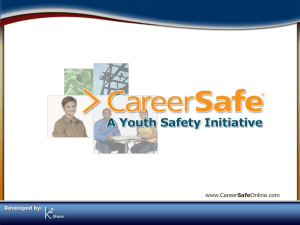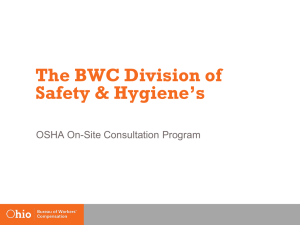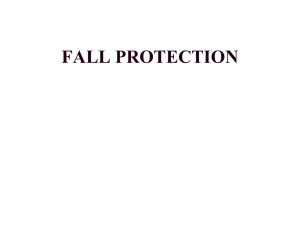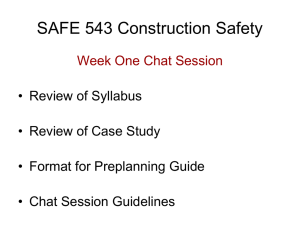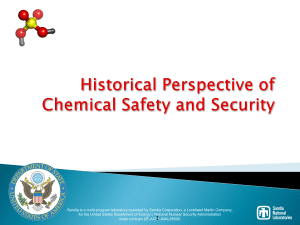Occupational Safety and Health Administration (OSHA) Office of
advertisement
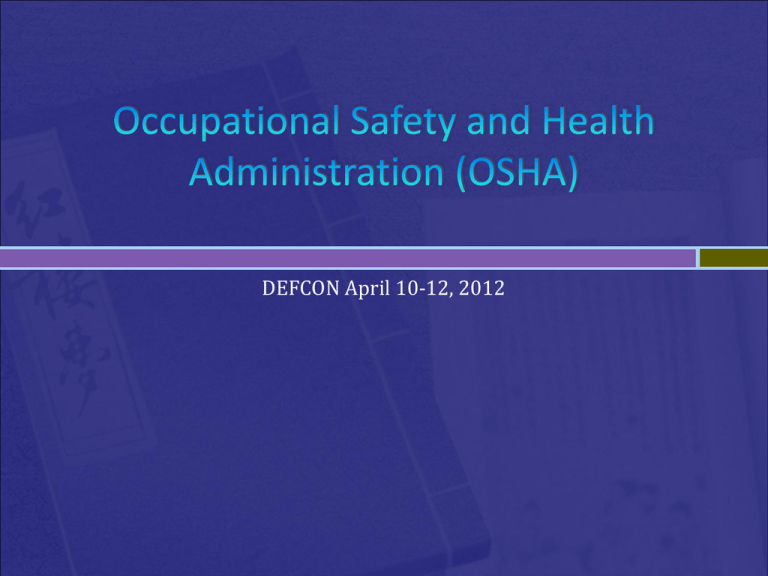
DEFCON April 10-12, 2012 APIC – Association for Professionals in Infection Control and Epidemiology, Inc. CDC – Center for Disease Control and Prevention CFR – Code of Federal Regulations DOL – Department of Labor EO – Executive Order FACOSH – Federal Advisory Council on Occupational Safety and Health MSDS – Material Safety Data Sheet NFPA – National Fire Protection Association NIOSH – National Institute for Occupational Safety and Health OSHA – Occupational Safety and Health Administration PEL – Permissible Exposure Limit SIC – Standard Industrial Classification 29 CFR Part 1910 – Occupational Safety and Health Standards 1910.1020 - Access to employee exposure and medical records 29 CFR Part 1960 – Basic Program Elements for Federal Employees OSHA 1960.26 - Conduct of inspections 1960.27 - Representatives of officials in charge and representatives of employees 1960.28 - Employee reports of unsafe or unhealthful working conditions 1960.29 - Accident investigation 1960.30 - Abatement of unsafe or unhealthful working conditions 1960.31 - Inspection by OSHA EO 12196 – Occupational Safety and Health Programs for Federal Employees (a) Each employer -(1) shall furnish to each of his employees employment and a place of employment which are free from recognized hazards that are causing or are likely to cause death or serious physical harm to his employees; (2) shall comply with occupational safety and health standards promulgated under this Act. (b) Each employee shall comply with occupational safety and health standards and all rules, regulations, and orders issued pursuant to this Act which are applicable to his own actions and conduct. 29 USC 654 • • • • • • • • • • • • Cooperation on injury prevention Stress/Workload Equipment/machinery Ergonomics Housekeeping Leased spaces/Confined spaces Employee Wellness Management acknowledgement Lack of training/equipment Blame the victim Food/drink facilities Traffic control Supervisory responsibility • Retaliation • Intimidation • Clothing allowance • Debris • Environmental • Respiratory • Ventilation • General awareness • Applicable standards (Which one takes precedence when there is a conflict?) • Chemical (i.e., asbestos) • Infectious Diseases • The Occupational Safety and Health Administration was established in 1971. Since then, OSHA and our state partners, coupled with the efforts of employers, safety and health professionals, unions and advocates, have had a dramatic effect on workplace safety. Fatality and injury rates have dropped markedly. Although accurate statistics were not kept at the time, it is estimated that in 1970 around 14,000 workers were killed on the job. That number fell to approximately 4,340 in 2009. At the same time, U.S. employment has almost doubled and now includes over 130 million workers at more than 7.2 million worksites. Since the passage of the OSH Act, the rate of reported serious workplace injuries and illnesses has declined from 11 per 100 workers in 1972 to 3.6 per 100 workers in 2009. OSHA safety and health standards, including those for trenching, machine guarding, asbestos, benzene, lead, and bloodborne pathogens have prevented countless work-related injuries, illnesses and deaths. This timeline highlights key milestones in occupational safety and health history since the creation of OSHA. http://www.osha.gov/osha40/timeline.html Who OSHA covers: Private Sector Workers Federal Government Workers State and Local Government Workers Condition: Must have OSHA-approved state program Not covered by OSHA: Self employed Immediate family members of farm employers that do not employ outside employees Workplace Hazards regulated by another Federal agency (for example, the Mine Safety and Health Administration, the Federal Aviation Administration, the Coast Guard). http://www.osha.gov/workers.html 1) Alaska 2) Arizona 3) California 4) Hawaii 5) Indiana 6) Iowa 7) Kentucky 8) Maryland 9) Michigan 10)Minnesota 11)Nevada 12)New Mexico 13)North Carolina 14)Oregon 15)South Carolina 16)Tennessee 17)Utah 18)Vermont 19)Virginia 20)Washington 21)Wyoming 22)Puerto Rico Workplace violence Infectious Disease with the exception of Blood Borne Pathogens (BBP) Air Quality Ergonomics Weight Limit *This is not all inclusive. Employers have the responsibility to provide a safe workplace. Employers MUST provide their employees with a workplace that does not have serious hazards and follow all relevant OSHA safety and health standards. Employers must find and correct safety and health problems. OSHA further requires employers to try to eliminate or reduce hazards first by making changes in working conditions rather than just relying on masks, gloves, ear plugs or other types of personal protective equipment (PPE). Switching to safer chemicals, enclosing processes to trap harmful fumes, or using ventilation systems to clean the air are examples of effective ways to get rid of or minimize risks. Employers MUST also: Inform employees about hazards through training, labels, alarms, color-coded systems, chemical information sheets and other methods. Keep accurate records of work-related injuries and illnesses. Perform tests in the workplace, such as air sampling required by some OSHA standards. Provide hearing exams or other medical tests required by OSHA standards. Post OSHA citations, injury and illness data, and the OSHA poster in the workplace where workers will see them. Notify OSHA within 8 hours of a workplace incident in which there is a death or when three or more workers go to a hospital. Not discriminate or retaliate against a worker for using their rights under the law. Designate Agency Safety and Health Official Conduct annual inspection File OSHA complaint(s) on behalf of employee(s) Part of Safety Inspection Team (annual) Workers' rights under the OSH Act Workers are entitled to working conditions that do not pose a risk of serious harm. To help assure a safe and healthful workplace, OSHA also provides workers with the right to: Ask OSHA to inspect their workplace Use their rights under the law without retaliation and discrimination Receive information and training about hazards, methods to prevent harm, and the OSHA standards that apply to their workplace. The training must be in a language you can understand Get copies of test results done to find hazards in the workplace Review records of work-related injuries and illnesses Get copies of their medical records http://www.osha.gov/workers.html • • • • • • • • • • SOPs/Policies/Training MSDS Labels/Containers Injury Reports/OSHA Logs (Form 300) Monitoring Medical Records Hazard Assessment Surveys Complaints Service logs/records for equipment • • • • • • • • • Past Practice Grievances Complaints Other/Government Occupational Safety and Health Administration (OSHA) Department of Labor (DOL) National Fire Protection Association (NFPA) Association for Professionals in Infection Control and Epidemiology, Inc. (APIC) Center for Disease Control and Prevention (CDC) National Institute for Occupational Safety and Health (NIOSH) If you believe working conditions are unsafe or unhealthful, we recommend that you bring the conditions to your employer's attention, if possible. You may file a complaint with OSHA concerning a hazardous working condition at any time. However, you should not leave the worksite merely because you have filed a complaint. If the condition clearly presents a risk of death or serious physical harm, there is not sufficient time for OSHA to inspect, and, where possible, you have brought the condition to the attention of your employer, you may have a legal right to refuse to work in a situation in which you would be exposed to the hazard. You have these options to file your safety and health complaint: 1. Online http://www.osha.gov/pls/osha7/eComplaintForm.html 2. Download and Fax/Mail – Download OSHA complaint form at http://www.osha.gov/oshforms/osha7.pdf. Complete and fax or mail to your local OSHA Regional or Area Office which can be found at http://www.osha.gov/html/RAmap.html. Include your name, address and telephone number so that an OSHA representative can contact you to follow up. 3. Telephone - your local OSHA Regional or Area Office. OSHA staff can discuss your complaint and respond to any questions you have. If there is an emergency or the hazard is immediately life-threatening, call your local OSHA Regional or Area Office or 1-800-321-OSHA. http://www.osha.gov/as/opa/worker/complain.html File a discrimination complaint if your employer has punished you for using any employee rights established under the OSH Act or for refusing to work when faced with an imminent danger of death or serious injury and there is insufficient time for OSHA to inspect. If you have been punished or discriminated against for using your rights, you must file a complaint with OSHA within 30 days of the alleged reprisal for most complaints. No form is required, but you must call or file a letter with the OSHA Area Office nearest you within 30 days of the alleged discrimination. In states with approved state plans, employees may file a complaint with both the State and Federal OSHA. Employees or their representatives have a right to request an inspection of a workplace if they believe there is a violation of a safety or health standard, or if there is any danger that threatens physical harm, or if an "imminent danger" exists. Employee representatives, for the purposes of filing a complaint, are defined as any of the following: An authorized representative of the employee bargaining unit, such as a certified or recognized labor organization. An attorney acting for an employee. Any other person acting in a bona fide representative capacity, including, but not limited to, members of the clergy, social workers, family members, government officials, nonprofit groups and organizations acting upon specific complaints and injuries from individuals who are employees. In addition, anyone who knows about a workplace safety or health hazard may report unsafe conditions to OSHA, and OSHA will investigate the concerns reported. How many employees work at the site and how many are exposed to the hazard? How and when are workers exposed? What work is performed in the unsafe or unhealthful area? What type of equipment is used? Is it in good condition? What materials and/or chemicals are used? Have employees been informed or trained regarding hazardous conditions? What process and/or operation is involved? What kinds of work are done nearby? How often and for how long do employees work at the task that leads to their exposure? How long (to your knowledge) has the condition existed? Have any attempts been made to correct the problem? On what shifts does the hazard exist? Has anyone been injured or made ill as a result of this problem? Have there been any "near-miss" incidents? 1. 2. 3. Elimination Substitution Engineering Controls – Encapsulation, Safety Measures, Ventilation Systems 4. Administrative Controls – Labeling Systems, Training, Rotating Workers – limit exposure, Work permit system – ONLY those who are qualified, and After Hours – when there is less traffic throughout the workplace 5. Personal Protective Equipment Problem Solving Root Cause Analysis Step 1: Identify/Document Step 1: Define the Problem Step 2: Remedy (Make employee whole) Step 2: Collect Data Step 3: Strategy Step 3: Identify Possible Causal Factors Step 4: Identify the Root Cause(s) Step 5: Recommend and Implement Solutions Step 1: Define the problem Who, What, When, Where, Why, and How Step 2: Collect Data Documentation is a MUST! What proof do you have that the problem exists? How long has the problem existed? What is the impact of the problem? From experts and front line staff who understands the situation and are most familiar with the problem. Tools to help identify causal factors (Steps 3-5): Appreciation – Use the facts and ask “So what?” to determine all the possible consequences of a fact. 5 Whys – Ask “Why?” until you get to the root of the problem. Drill Down – Break down a problem into small, detailed parts to better understand the big picture. Cause and Effect Diagrams – Create a chart of all of the possible causal factors, to see where the trouble may have begun. Step 3: Identify Possible Causal Factors What sequence of events leads to the problem? What conditions allow the problem to occur? What other problems surround the occurrence of the central problem? Step 4: Identify the Root Cause(s) Why does the causal factor exist? What is the real reason the problem occurred? Tools to help identify causal factors: Appreciation – Use the facts and ask “So what?” to determine all the possible consequences of a fact. 5 Whys – Ask “Why?” until you get to the root of the problem. Drill Down – Break down a problem into small, detailed parts to better understand the big picture. Cause and Effect Diagrams – Create a chart of all of the possible causal factors, to see where the trouble may have begun. Step 5: Recommend and Implement Solutions What can you do to prevent the problem from happening again? How will the solution be implemented? Who will be responsible for it? What are the risks of implementing the solution? Plan ahead / Spot potential failures before they happen: Failure Mode and Effects Analysis (FMEA) – This tool builds on the idea of risk analysis to identify points where a solution could fail. Impact Analysis – This helps you explore possible positive and negative consequences of a change on different parts of a system or organization. Kaizen (aka Continuous Improvement) – This is the idea that continual small changes create better systems overall. It also emphasizes that the people closest to a process should identify places for improvement. • • • • • • Department of Labor http://www.dol.gov/index.htm Occupational Safety and Health Administration - http://www.osha.gov Office of Workers’ Compensation Program - http://www.dol.gov/owcp/ Association for Professionals in Infection Control and Epidemiology, Inc. http://www.apic.org/ National Fire Protection Association – http://www.nfpa.org Center for Disease Control and Prevention - http://www.cdc.gov/


